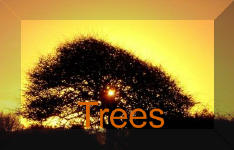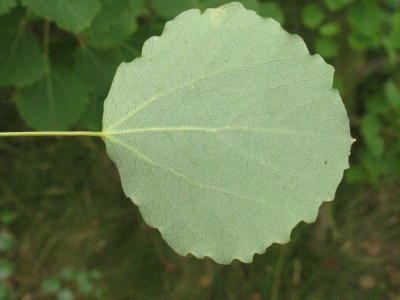Aspen (Populus tremula)
Aspen (Populus tremula)
BACK TO


Family - Salicaceae Explanation of Latin name: The Latin name means trembling poplar. The name Populus is derived from arbor populi, the ‘tree of the people’. Populus is also the Latin form of the Greek papaillo meaning to shake, a reference to the fluttering leaves Tremula is used because the leaves tremble in the breeze. Other poplars make a similar sound but the aspen has loosely toothed leaves which increase the effect. They sound like a rustling whisper as if being spattered by rain drops.
Description:
fast growing, deciduous.
Shape: The aspen has a broad open crown, is lightly branched with twisting branches. The lower branches are often horizontal. Height: 20 to 30 metres tall
LeavesThe shoots are tiny and deep brown, the leaf buds yellow and deep brown and slightly sticky. The leaves are almost circular, with large rounded teeth and taper to a small point. The stalks are as long as the leaves and are flat and very flexible. They join the leaves at right angles. The leaves are 3 – 8 cm across. They unfold copper-brown but change to a dull rich greyish-green above and pale grey-green beneath. They are slightly hairy when young but hairless later. In autumn they are a good clear yellow before falling.

9634

9633

Flowers:Aspen is a member of the willow family, and like all willows it has separate male and female trees. The technical term for this is ‘dioecious’. Before the leaves appear the flowers on male trees are dense dangling catkins, 11 cm long and grey-brown. When they have shed their pollen the catkins turn reddish-brown and fall to the ground soon after. On female trees catkins of a similar length are green with brown bracts.
Fruit:The female trees catkins produce two little capsules with tiny seeds inside. These are attached to small cottony grey hairs to help with dispersal. In mid May these catkins are woolly and white. They shed their seeds soon afterwards.
BarkThe bark is grey-green getting darker when the tree is older. It is ridged in older trees.
LocationFound all over Europe, North Africa, Turkey and Siberia. It is frequently found in damp hillsides, rocky valley bottoms, hedges and copse edges. It will grow in a wide range of different soils but loves moisture and light. It is a deep rooted tree that is not damaged by frost but hates to be too dry or too hot. It grows from airbourne seeds, but also spreads itself to form small groves by suckers from the roots. The movement of the leaves allows light to fall on the plants under it so a rich variety of wild flowers can grow there. It is mature in 50 years.
Phenology:
Flowers Leaves Fruit Ripen Fall
March April/May May OctoberUses
In Medieval times the timber was used to build houses for the poor who could not afford to use oak. The wood is soft but it lasts well if it is kept dry. It is light, white or pale yellow and not splintery. The bark was used for tanning leather, for turning objects made on a lathe and for making barrels. The charcoal made from aspen was considered best for the making of gunpowder. It has always been used for making clogs but Henry 5th protected it against it being used for this purpose as it was so good for making arrows. Nowadays it is used for making matches, clogs, and pulp for paper and card. It is also good for producing lightweight boxes for fruit and vegetables and for veneer and plywood. Beavers use aspen bark as their principal food and deer, sheep, goats and cattle like to eat the leaves more then those of any other tree.
Similar species:
Grey Poplar, but aspen leaves have no hairs beneath and they flutter more readily.
Folklore & History
: The aspen was one of the first trees to return to Britain after the Ice Age, 9000 years ago. It is therefore considered to be a ‘native’ tree. In Wales, it was believed that the aspen could never rest because it was cursed as ‘the tree on which Christ was crucified’. Many other traditions explain the trembling of the leaves in a similar way. In Scotland for example, aspen wood is little used because of the tree’s folklore.
Growth & Propagation :
Naturally distribution by airborne seed. Should not be planted near buildings or drains. Seed quickly lose their vigour but fresh seed germinate quickly. Unlike Black poplar and hybrids not easy to grow from sets.